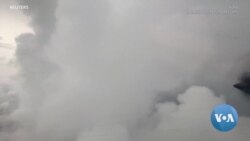Hurricane Ida, which made landfall in the U.S. Gulf Coast state of Louisiana as a dangerous Category 4 storm, has weakened to a Category 3 storm as it approaches New Orleans, the U.S. National Hurricane Center (NHC) said Sunday night.
The storm, still packing maximum sustained winds of 200 kph (125 mph), will pass to the west of New Orleans.
The NHC urged residents to expect high winds, 15-50 centimeters (6-20 inches) of rain across the Louisiana, Mississippi and Alabama coasts, and storm surges predicted to exceed 2 meters (6 feet).
Hurricane warnings were in effect for Intracoastal City, Louisiana, to the mouth of the Pearl River as well as Lake Pontchartrain, Lake Maurepas and metropolitan New Orleans.
Sixteen years ago, August 29, 2005, Hurricane Katrina came ashore in Louisiana as a Category 3 storm. Katrina was blamed for 1,800 deaths, levee breaches and devastating flooding in New Orleans. The city’s federal levee system has been improved since then, and Louisiana Governor John Bel Edwards predicted the levees would hold.
"Will it be tested? Yes. But it was built for this moment," he said.
Before Ida arrived, Edwards declared a state of emergency and said 5,000 National Guard troops were standing by along the coast for search and rescue efforts. In addition, 10,000 linemen were ready to respond to electrical outages once the storm passed.
Alabama Governor Kay Ivey also declared a state of emergency for coastal and western counties in the state.
New Orleans Mayor LaToya Cantrell ordered people who live outside the city’s protective levee system to evacuate. And she urged those who remained in the city to hunker down.
As of Sunday evening, at least 700,000 homes in Louisiana had lost electricity, according to PowerOutage website.
"As soon the storm passes, we're going to put the country's full might behind the rescue and recovery," President Joe Biden said after a briefing at the headquarters of the Federal Emergency Management Agency in Washington.
The president said he had signed emergency declarations for Louisiana and Mississippi and has been in touch with the governors of those two states and Alabama. The Gulf Coast region’s hospitals now face a natural disaster as they are struggling with a surge in patients with COVID-19, the disease caused by the coronavirus, due to the highly contagious delta variant.
“COVID has certainly added a challenge to this storm,” Mike Hulefeld, executive vice president and chief operating officer of Ochsner Health, told the Associated Press.
Edwards said about 2,500 people are being treated for COVID-19 in the state’s hospitals as the hurricane passes through.
Since the start of the pandemic, Louisiana has had 679,796 confirmed cases of COVID-19 and 12,359 deaths, according to the Johns Hopkins Coronavirus Resource Center. Its vaccine tracker says just 41% of the state’s nearly 4.7 million population are vaccinated.
“Once again we find ourselves dealing with a natural disaster in the midst of a pandemic,” Jennifer Avegno, the top health official for New Orleans, told the AP.
Ida made landfall Friday in Cuba, and by Saturday the cleanup was under way. Trees were toppled and buildings damaged, but no deaths were reported.
Some information for this report came from The Associated Press and Reuters.











